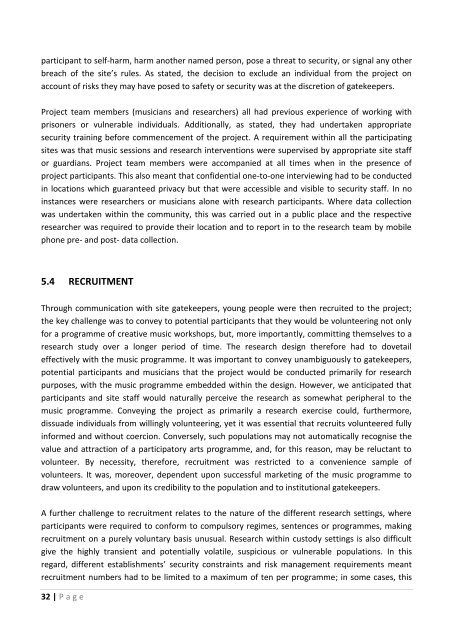De Viggiani, N., Daykin, N., Moriarty, Y. and Pilkington, P. and ...
De Viggiani, N., Daykin, N., Moriarty, Y. and Pilkington, P. and ...
De Viggiani, N., Daykin, N., Moriarty, Y. and Pilkington, P. and ...
Create successful ePaper yourself
Turn your PDF publications into a flip-book with our unique Google optimized e-Paper software.
participant to self-harm, harm another named person, pose a threat to security, or signal any other<br />
breach of the site’s rules. As stated, the decision to exclude an individual from the project on<br />
account of risks they may have posed to safety or security was at the discretion of gatekeepers.<br />
Project team members (musicians <strong>and</strong> researchers) all had previous experience of working with<br />
prisoners or vulnerable individuals. Additionally, as stated, they had undertaken appropriate<br />
security training before commencement of the project. A requirement within all the participating<br />
sites was that music sessions <strong>and</strong> research interventions were supervised by appropriate site staff<br />
or guardians. Project team members were accompanied at all times when in the presence of<br />
project participants. This also meant that confidential one-to-one interviewing had to be conducted<br />
in locations which guaranteed privacy but that were accessible <strong>and</strong> visible to security staff. In no<br />
instances were researchers or musicians alone with research participants. Where data collection<br />
was undertaken within the community, this was carried out in a public place <strong>and</strong> the respective<br />
researcher was required to provide their location <strong>and</strong> to report in to the research team by mobile<br />
phone pre- <strong>and</strong> post- data collection.<br />
5.4 RECRUITMENT<br />
Through communication with site gatekeepers, young people were then recruited to the project;<br />
the key challenge was to convey to potential participants that they would be volunteering not only<br />
for a programme of creative music workshops, but, more importantly, committing themselves to a<br />
research study over a longer period of time. The research design therefore had to dovetail<br />
effectively with the music programme. It was important to convey unambiguously to gatekeepers,<br />
potential participants <strong>and</strong> musicians that the project would be conducted primarily for research<br />
purposes, with the music programme embedded within the design. However, we anticipated that<br />
participants <strong>and</strong> site staff would naturally perceive the research as somewhat peripheral to the<br />
music programme. Conveying the project as primarily a research exercise could, furthermore,<br />
dissuade individuals from willingly volunteering, yet it was essential that recruits volunteered fully<br />
informed <strong>and</strong> without coercion. Conversely, such populations may not automatically recognise the<br />
value <strong>and</strong> attraction of a participatory arts programme, <strong>and</strong>, for this reason, may be reluctant to<br />
volunteer. By necessity, therefore, recruitment was restricted to a convenience sample of<br />
volunteers. It was, moreover, dependent upon successful marketing of the music programme to<br />
draw volunteers, <strong>and</strong> upon its credibility to the population <strong>and</strong> to institutional gatekeepers.<br />
A further challenge to recruitment relates to the nature of the different research settings, where<br />
participants were required to conform to compulsory regimes, sentences or programmes, making<br />
recruitment on a purely voluntary basis unusual. Research within custody settings is also difficult<br />
give the highly transient <strong>and</strong> potentially volatile, suspicious or vulnerable populations. In this<br />
regard, different establishments’ security constraints <strong>and</strong> risk management requirements meant<br />
recruitment numbers had to be limited to a maximum of ten per programme; in some cases, this<br />
32 | P a g e
















